Testing iPhone 6 Plus battery w/o bending
Posted by Wesley on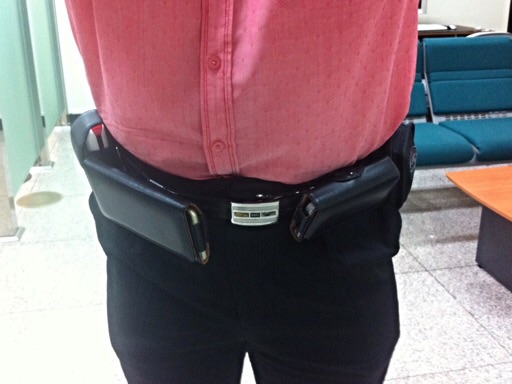
iPhone 6 Plus (left) and 5S (right) worn on the waist
I've been doing a comparison test of battery life between iPhone 6 Plus and iPhone 5S for a few days. While that was happening, a bit of brouhaha over how iPhone 6 and 6 Plus supposedly bends in your pocket had been circulating the internet. It turned out that the whole thing was overblown as I suspected, and I already pointed out that it was okay to put it in the front pockets in general even before this so-called "bendgate / bendghazi" rolled in.
In any case, my belt cases work quite well. I try to use both phones identically when doing battery life comparison, so I have to have them carried around as close to me as possible. So I had my iPhone 5S strapped to my left side, while the 6 Plus took up my right side as you can see here. No worries about bending, and easy to get it out quickly, too. In normal times, I simply have one less iPhone on my waist.
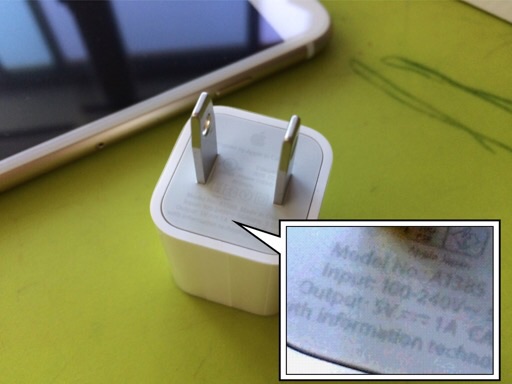
iPhone 6 Plus ships with a 5W (= 5V x 1A) charger
As for the charging comparison side of things, Apple decided to save a bit of money on the charger. Although iPhone 6 Plus has nearly twice the battery charge as the previous models, it still ships with the same 5W charger. This is similar to how iPad mini ships with a 5W one instead of a 10W or 12W one like the "normal" iPads.
It's disappointing that Apple opted to do this, but maybe it isn't all that bad. The only way to find out is through testing. In order to see how much of an impact a lower-powered charger would cause, I prepared both 5W and 10W Apple-branded chargers for the tests.
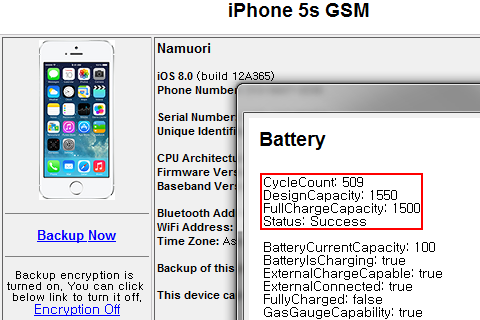
Battery capacity of 1500mAh showing for iPhone 5S
To have a fair test, I checked how much capacity is left in each of the devices. After all, my iPhone 5S had been with me for one full year. If the capacity had been reduced significantly, it couldn't be used for the tests. As it turns out, my 5S had been holding up pretty well - having 1500mAh left from 1550mAh (or about 1560mAh = 5.92Wh / 3.8V) of design capacity after more than 500 charge cycles. That's more than 96% of the original capacity left, and thus good enough for the tests.
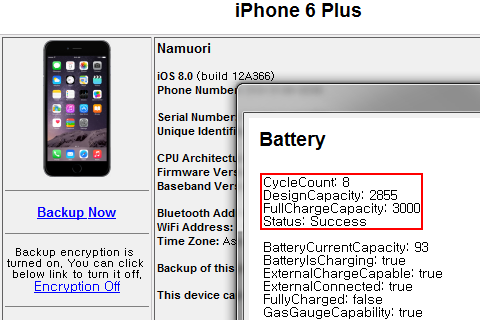
Battery capacity of 3000mAh showing for iPhone 6 Plus
I did the check with my iPhone 6 Plus, too. Compared to the design capacity of 2855mAh (or about 2910mAh = 11.1Wh / 3.82V), it was doing a bit too well, at 3000mAh. It was showing off how new it was.
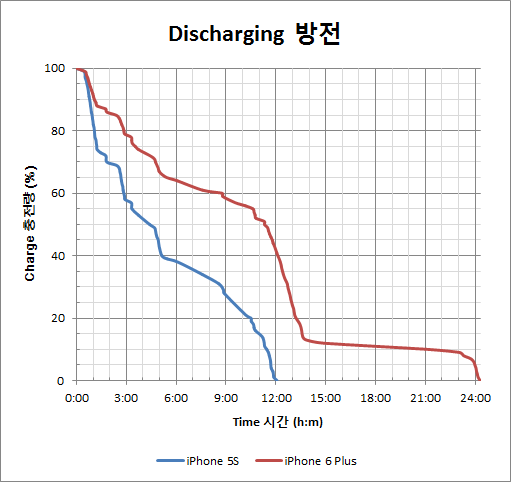
Discharging trend for iPhone 5S & 6 Plus in real life use
The discharge test kept both phones in as similar state as possible while using them naturally in real life, doing stuff like browsing the web and taking photos. The installed apps and their notification settings were the same, and the OS were both at iOS 8.0 GM. GPS, Wi-Fi, and Bluetooth were enabled, but data communication relied on LTE only. The screen brightness was fixed at 50%. I even created The Toon-Box cartoon on both devices at the same time as part of the test.
The result was that the large battery on the iPhone 6 Plus had a big advantage. The battery drained at about half the speed of iPhone 5S overall. So while the 5S lasted 12 hours and 4 minutes, 6 Plus still had 41% charge left. The 6 Plus had another 100 minutes of various use, then it was kept idle for about 9 hours (I slept) before getting another 80 minutes of use until it died at 24 hours and 18 minutes mark.
Even when the night-time idling is not taken into consideration, the battery life of iPhone 6 Plus was wonderful. I hadn't had a phone last a full day for quite a while because I kept installing a lot of apps and the complexity of iOS kept growing. I guess I'm ready to get some widgets on the notification center without too much fear of battery drain.
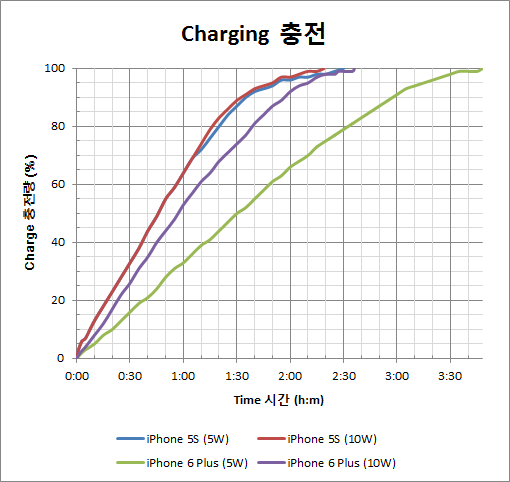
Charging trend of iPhone 5S & 6 Plus using two types of chargers
But with large battery comes long charge time. Using the official chargers, iPhone 5S got charged in 2 hours and 19 minutes with a 10W one, while 5W one took 2 hours and 30 minutes. The difference is small, and the 10W result is consistent with last year's. Until about 80% mark, the phone gets charged at the rate of 10% every ten minutes. Then it gradually slows down. With the 5W charger, the slowdown happens slightly faster.
Meanwhile, it takes 3 hours and 48 minutes for the 5W charger to fill up the iPhone 6 Plus, which is about 50% slower. Before starting to slow down at around 75% mark, it is charged at 5.5% every ten minutes. So it takes twice as long to get to the 80% mark. This mark for iPhone 6 Plus is incidentally when iPhone 5S gets fully charged.
Using the 10W charger is much better for iPhone 6 Plus, as expected. While it still doesn't charge up as quick as iPhone 5S, getting 8.5% every ten minutes, the slowdown is less gradual, finishing the charge in 2 hours and 36 minutes. This isn't much different from iPhone 5S. I expect the 12W charger that's shipped with newer iPads would create a charge curve that's nearly identical to that of 5S.
If you consider that the iPhone 6 Plus has more charge left in the daily use compared to the smaller models, then the 0-to-100% charge time matters less because it's charging from a higher point. This might be why Apple thought it would be fine to include a 5W charger. This is understandable, but if you use your phone a lot, then getting a higher-rated charger is recommended.
To summarize, iPhone 6 Plus has a great battery life. Also, get a 12W (or at least 10W) charger to charge it up like the smaller iPhones.